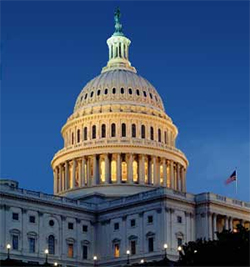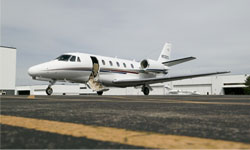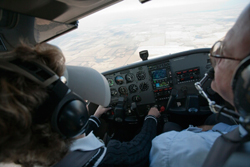In a tough year for general aviation, plagued with a tanking economy and sinking public perception, the industry found allies in an unusual place—on Capitol Hill. This year, GA enjoyed unprecedented support from Congress: The House and Senate each created a General Aviation Caucus; and Democrats and Republicans alike supported the GA Serves America campaign, provided funding for airports, and fought proposed security requirements that could have crippled the struggling industry.

In a tough year for general aviation, the industry found allies in an unusual place—on Capitol Hill.
The support from Congress, in addition to collaboration among GA advocacy associations, helped temper what once loomed as a year of new user fees and stricter government regulation.
“We started with a tough year ahead of us—one of the most challenging years in the history of general aviation,” said AOPA President Craig Fuller. “We joined with other GA associations on numerous issues to make our voices heard on Capitol Hill and in the FAA and TSA. As an industry, we’ve made great strides this year on the advocacy front, especially thanks to our vocal supporters in Congress.”
Reps. Allen Boyd (D-Fla.) and Vernon Ehlers (R-Mich.) founded the House General Aviation Caucus in May, while Sens. Mark Begich (D-Alaska) and Mike Johanns (R-Neb.) formed the Senate version in September. Dozens of representatives and senators have joined the caucuses, with the goal of helping their colleagues to better understand the importance of GA. In addition to sticking up for GA on funding issues, members of the caucuses also put the brakes on runaway security proposals.
“This caucus provides a great opportunity to help educate members of Congress and their staffs about the current issues facing AOPA members,” said AOPA Vice President of Legislative Affairs Lorraine Howerton. “It will help us in our efforts to protect general aviation on all fronts, including public perception, user fees, and security.”
User fees staved off another year
In February, the White House Office of Management and Budget released the administration’s budget proposal, which included a footnote calling for “direct user charges” to replace some aviation excise taxes in order to help fund the FAA. The same month, aviation industry groups joined together to call on Congress to pass a long-term FAA funding bill that eliminated the threat of user fees.
The House passed a long-term FAA funding bill in May, and another is under consideration in the Senate. Both would use aviation fuel taxes, ticket taxes, and a general fund contribution to fund the FAA. However, with time running out at the end of the year, the House and Senate passed another short-term extension to provide the FAA with funding through March 31, 2010. Although user fees are still on the White House agenda for 2011, 118 members of Congress already have informed the president that any plan that includes user fees or direct user charges would be rejected.
“The fight against user fees is far from over,” said Howerton. “However, with the help of these members of Congress, we are sending a strong message that user fees are not a viable funding mechanism.”
The concerted push for a long-term FAA funding bill comes in part because of the need to fund NextGen, a modernized, satellite-based air traffic control system. This year, a government-industry task force released its recommendations for implementing NextGen. AOPA participated in the task force to ensure GA pilots would continue to have access to the airspace under the new system and to recommend incentives for pilots to equip with the avionics necessary to fly in the new system. The association will become more involved in NextGen, as Fuller recently was appointed to the board of directors and policy board for RTCA, the group that headed the NextGen task force group. The modernized air traffic control system should increase efficiency, provide more access to airports, and relieve traffic congestion.
Aviation, airport funding protected

Many airports received much-needed funding through the American Recovery and Reinvestment Act, or stimulus program.
As states across the country looked for ways to trim their budgets, some eyed funds that were designated for GA airports.
Arizona Gov. Jan Brewer proposed raiding the state aviation fund of $14.6 million to alleviate budget deficits, while the Ohio Senate cut all state funding for airports because of its budget shortfall. AOPA called on its members in both states to contact their elected officials, explain the importance of funding for aviation infrastructure, and urge them to restore the funding. And both states listened. The Arizona legislature preserved most of the state aviation fund, and Ohio ultimately restored 80 percent of its funding for airports.
“Many legislators looked at GA as an easy target,” said Greg Pecoraro, AOPA vice president of airports and state advocacy. “But our members quickly proved to their elected officials that GA is a critical part of the national and local transportation infrastructure that can’t be overlooked.”
While AOPA fought at the state level to protect aviation funds, many airports received much-needed funding through the American Recovery and Reinvestment Act, or stimulus program.
The stimulus package included $1.1 billion for airports that had “shovel ready” projects. And GA airports were ready with their lists of projects thanks to advance notice from AOPA about the package. The association contacted governors, state aviation directors, and other local officials to urge them to organize the infrastructure projects that would qualify for the funding. The first GA airport project to receive stimulus funding was Pennsylvania’s Allegheny County Airport, which needed the money to renovate a taxiway and relocate a ramp.
Although the stimulus package came under sharp criticism and GA airports were targeted by the media as undeserving of the funding, many airports across the nation were able to complete their infrastructure enhancements—and do so under budget. Numerous times, Fuller came to the defense of GA airports after slanted news reports further threatened the perception of GA.
Airports: Protecting an endangered species
Funding is just one of the factors that influence an airport’s success. A community’s perception of its airport is often the cause of the field’s success or demise, so AOPA works at the local level through a team of Airport Support Network (ASN) volunteers to enhance the public’s perception of its local airport and defend the facility when problems arise.
This year, the network grew to a record 2,000 volunteers across the country. Many of the volunteers played key roles in protecting the airports.

AOPA’s 2009 Let’s Go Flying Sweepstakes airplane made the trip to Plainville for an airport open house.
In North Las Vegas, ASN volunteer Kathleen Snaper and the Clark County Aviation Association played an instrumental role in helping AOPA and the Air Safety Foundation prevent a flight ban on high-risk and experimental flights at the airport. Two fatal accidents in August 2008 sparked outcry among local residents, and the Nevada Senate considered a precedent-setting bill that would have granted local officials the authority to ban certain flight operations at the airport. While the foundation reached out to local pilots to improve safety, AOPA took the lead in working with the state legislature to craft a compromise that removed the precedent-setting language from the bill and created a task force of aviation officials and state and local residents to study ways to enhance safety at the airport.
Meanwhile, in other areas of the country, volunteers worked to establish positive community-airport relationships.
Neal Witkin, the ASN volunteer at Robertson Field in Plainville, Conn., worked with AOPA to educate the community of the value of the airport. The town had a choice: purchase the airport or allow it to be closed and sold to a real estate developer. In advance of a referendum to purchase the airport, AOPA’s 2009 Let’s Go Flying Sweepstakes airplane made the trip to Plainville for an airport open house that attracted more than 2,000 people. The community voted to buy the airport.
A similar scenario presented itself in Washington. The city of Kennewick in Washington wanted to sell the Vista Field to developers. However, the local chapter of the Washington Pilots Association and ASN volunteer Marjy Leggett banded together to protect the airport and help pro-airport candidates get elected to the port of commissioners and city offices. Five of the seven pro-airport candidates were elected, putting a much more positive face on the fate of the field.
Security front: Access to airports and airspace

TSA’s proposed Large Aircraft Security Program (LASP) generated pilot outrage across the nation.
Thousands of pilots commented on the Transportation Security Administration’s proposed Large Aircraft Security Program this year, opposing the measure because it would have imposed on citizens’ right to privacy and freedom to travel, cost the GA community more than $1 billion a year, and impose burdensome regulations based on undocumented security threats.
Members of Congress as well as state legislators from South Carolina to Alaska called on the Department of Homeland Security to create an alternative. The outrage generated by the proposal, which would have required airline-style security requirements for aircraft weighing more than 12,500 pounds, forced the TSA to rethink its approach. AOPA met with security officials multiple times to explain the difference between GA and airline operations. In response to pressure from pilots and Congress, the agency scrapped its original proposal and is currently working on a negotiated rulemaking.
The Large Aircraft Security Program wasn’t the only regulation the TSA tried to force on GA this year. The agency released Security Directive 8F to airport operators without any input from or forewarning to the GA industry. The directive required based and transient pilots to submit to background checks and obtain security badges in order to maintain access to certain air carrier airports. AOPA met with the TSA numerous times to mitigate the directive, and the agency ultimately issued a second version, Security Directive 8G, which lessened the regulations on transient pilots who fly into commercial-service airports. Transient pilots do not need to get an airport badge or submit to a background check. However, they must remain close to their aircraft, leaving it only to walk to and from the fixed-base operator, service provider, or airport exit.
In the wake of the backlash created by the security directives, Congress stepped in to try to limit the TSA’s authority to issue the directives without notice or public input. In September, Reps. John Mica (R-Fla.), Tom Petri (R-Wis.), Allen Boyd (D-Fla.), Vernon Ehlers (R-Mich.), and Sam Graves (R-Mo.) introduced an amendment to the TSA authorization that passed the House in June that would clarify that security directives can be issued in order to respond to an imminent threat of finite duration. However, directives that would remain in effect for more than 90 days would require revision after 90 days, and any directive that would be in effect for more than 180 days would be required to go through the public rulemaking process.
Pilots proved that when government agencies consider pilots’ input and create a system based on users’ needs, it can work. Within the first year Customs and Border Protection’s implementation of its Electronic Advance Passenger Information System (eAPIS), pilots successfully used the system and flew across U.S. borders without a single fine being levied (fines can range from $5,000 to $10,000).
As originally proposed, eAPIS was as unworkable and burdensome as the proposed Large Aircraft Security Program and Security Directive 8F. It would have required pilots to submit electronic manifests within one hour of departing the United States. It made no allowances for pilots operating to and from backcountry strips in Canada, Mexico, or the Bahamas where Internet access can be spotty or nonexistent. During the comment period, pilots pointed out that the proposed system would not work and suggested alternatives. Customs considered pilots’ input and changed the system to allow pilots to submit their information as far in advance as they like. Pilots also can update certain information about their flight via telephone, radio, or flight service. AOPA is still working with customs to try to eliminate the outbound filing requirements to ease the burden on pilots.
“This is a perfect example of how government agencies can work with pilots to create a feasible system for everyone,” said Craig Spence, AOPA vice president of operations and international affairs. “This is a model we hope the TSA will follow as it reworks its proposed Large Aircraft Security Program.”

AOPA participated in the New York Hudson River Task Force to develop recommendations that would improve safety through the New York airspace.
The government also worked closely with the GA industry in the wake of the fatal midair collision over the Hudson River in August. As a result, the airspace above the river is still open to pilots.
AOPA participated in the New York Hudson River Task Force to develop recommendations that would improve safety in the tight space while keeping it open as a viable transition route for VFR aircraft to navigate through the New York airspace. The agency moved quickly, adopting the group’s recommendations and creating a special flight rules area by mid-November. In order to help pilots better navigate the area, learn about the special flight rules area, and operate in congested airspace, the AOPA Air Safety Foundation hosted safety seminars in the New York City area.
Keeping training, maintenance affordable
Flight training, currency requirements, and aircraft maintenance costs can add up quickly, putting a dent in the amount of money pilots have left to fly for pleasure. That’s why AOPA works at the national and state level to try to keep flying affordable, weighing in on measures that would increase the cost of flying or aircraft ownership without providing any real benefit to the GA community.

The FAA put to rest a proposal that threatened to dramatically increase the amount of time—and money—required to maintain instrument currency.
In August, the FAA put to rest a proposal that threatened to dramatically increase the amount of time—and money—required to maintain instrument currency. The agency had proposed new instrument currency requirements in 2007 (AOPA opposed) that would have mandated pilots to perform precision and nonprecision approaches; fly a missed approach; hold at a “radio station,” intersection, or waypoint; and conduct a one-hour cross-country flight, in addition to the current requirements.
“This would have imposed a huge cost burden on pilots without enhancing their safety,” said Rob Hackman, AOPA vice president of regulatory affairs. “The cross-country requirement especially would have made it difficult.”
The association also prevented an airworthiness directive (AD) on float-type carburetors that would have affected 127,000 aircraft— more than half of the U.S. GA fleet. Although AOPA does not oppose ADs that are proven to be critical to the safety of flight, this directive would have been too broad and lacked specific evidence to support a required action. Instead of issuing an AD, the FAA considered AOPA’s position and instead issued a special airworthiness information bulletin, which alerts pilots to the hazards of float-type carburetors and recommends special procedures for examining and monitoring the carburetor but stops short of requiring action.
At the state level, AOPA jumped into action when a sales tax exemption on aircraft maintenance or repair in New York was set to expire. The exemption was enacted in 2004 and would have expired Dec. 1 this year. While the state Assembly passed a bill to make the exemption permanent, the deal was threatened by a five-week power struggle in the Senate. Ultimately, the state went a step further than extending the exemption, making it permanent. The move will attract more aviation business to the state and help aircraft owners save money.
Meanwhile, new aircraft owners received a helping hand from AOPA. The association worked with Florida revenue officials to sort out a confusing use-tax on new out-of-state aircraft. Confusion abounded about when out-of-state aircraft owners who purchased an aircraft within six months of their visit to Florida could have been hit with a use tax for 6 percent of the aircraft’s value (or the difference between the sales tax in their state and the use tax in Florida). Officials clarified their guidance to exempt recently purchased out-of-state aircraft that were flying into Florida for AOPA Aviation Summit this fall. AOPA will work with state elected officials next year to pass a bill granting a broader use-tax exemption.
Preparing for a new year
As a new year approaches, it brings with it new threats to GA. What will the new proposed Large Aircraft Security Program entail? What airports will be threatened with closure? How will the FAA be funded? Once again, AOPA will be pooling its resources and allies at the local, state, and national level to thwart these threats and help to keep GA safe, fun, and affordable.
“We’ve had a tough year, and we’re preparing for another difficult one,” Fuller said. “But we have a dedicated, passionate group working every day on Capitol Hill, with the FAA, and with various security agencies.
“As it is with our members, GA also is our vocation and avocation, and we’re going to protect it.”



